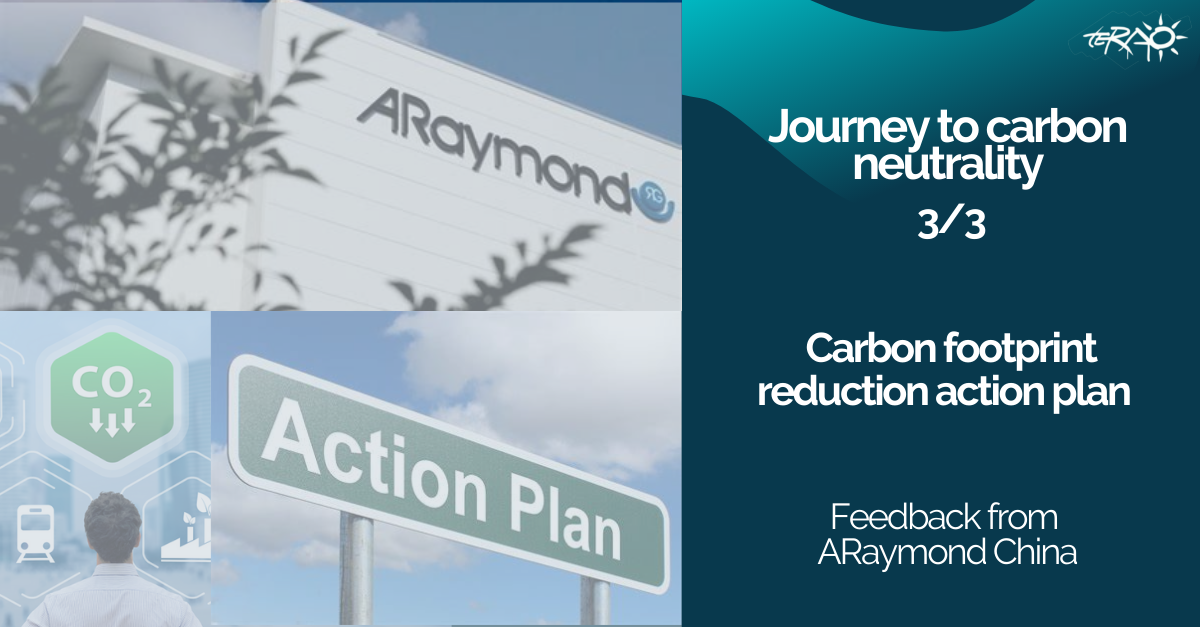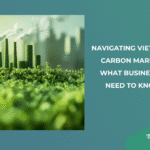[Part 3]
How can TERAO help you to assess your carbon footprint?
After our first article about Data Collection, and second article about Quantification, here is the introduction and the client feedback on the 3rd step of the carbon footprint assessment: carbon emissions reduction roadmap.

Without further ado, here is the third step: how to reduce carbon emissions!
Project background
ARaymond Group is an international company with headquarters in France and several branches in China, USA, India etc. They have decided to reduce their carbon footprint in line with Paris Agreement. To be able to reduce the carbon footprint, one must first know the quantity of carbon emissions due to their activities.

TERAO team was appointed by ARaymond China as a carbon footprint specialist to assess their carbon footprint and help them set up a preliminary roadmap for carbon emissions reduction.
Methodology
The main steps of the carbon footprint calculation and carbon reduction action plan establishment are:
- Step 1: Set up boundaries – what to include in the carbon footprint calculation? – and Data collection – which data to collect? which data is available?
- Step 2: Quantification – calculation of the footprint
- Step 3: Carbon emissions reduction Roadmap – how to reduce the carbon emissions?
Phase Ⅲ – Carbon emissions reduction Roadmap – feedback from the client
Now we have finally come to the final step, after calculations and assessments, we are going to give some reduction strategies!
Here is the feedback from our client, ARaymond China, especially, Mr. Nicolas Perret, whose role was to sponsor (support) the whole carbon footprint assessment from the company side.
1- Did the action plan make you rethink the way your company could operate?
Mr. Nicolas Perret:
Yes and no. We actually had started the process of questioning how our company was operating before starting the Carbon footprint mission. Actually, the action plan is a key part of the process we had started of questioning and changing the way we operate.
On the other hand, it brought out the challenge of how to involve all individuals of the company. This topic should not remain only the problem of the management and the HSE department. It proved difficult to get everyone on board which is necessary to create lasting change.
To solve this problem, the group has now set up internal training processes through the identification of “biodiversity and climate change experts” who organize workshops for all employees.

(generic picture, not ARaymond employees)
2- In addition to the direct reduction of Carbon emissions, can you think of other positive results which will be brought by the Carbon footprint reduction action plan?
Mr. Nicolas Perret:
We got the opportunity to rethink our packaging process, looking for ways now to reduce and reuse when possible.
On the logistic part, we have been as well rethinking the flows, as well as the means. For example, we just got the green light to switch to training for the goods currently imported from Europe by boat.

We are rethinking the logistics by considering setting up so-called “advanced service centers” in major regions. We could be able to handle some processes closer to the client side. By switching part of palette to truck transportation we would reduce the Carbon content of our products.
Actually, Carbon emissions and energy consumption are now included in our investment criteria.
However, we realized that changing mindsets takes longer than optimizing our operations and this is one of our current challenges.

3- Could you mention 3 strategies of the action plan that particularly sparked your interest?
Mr. Nicolas Perret:
Beyond the logical and mandatory strategies that had to be done and that we are doing such as energy efficiency and solar photovoltaic, here are other strategies:
- ARaymond wants to promote electric cars for its employees. However, electricity in Jiangsu has a high Carbon content. Therefore, by covering the parking lot with solar panels that will be used to charge cars we would help people have a real impact with their electric cars by charging them with Carbon-free electricity.

2. We are installing green walls which not only have a direct well-being impact, they are also an external and internal tool to push environmental consciousness.

3. Regarding purchased material, moving from 25kg bags to 500kg or 1t boxes is leading to a decrease in material loss. To enable this change, we implemented last year a dedicated unloading system. Moreover, this change leads to a reduction in packaging material by limiting 25kg bags.
In a nutshell, the action plan provided us with Carbon emissions reduction strategies covering all aspects of our operations. This approach is mandatory if we want to reach our company targets. Indeed, we need to rethink and optimize how we operate.
Big thanks to Mr. Nicolas Perret for his time and feedback on their experience of Step 3 of a carbon emission reduction roadmap. This is actually a crucial step for Araymond to kick off its carbon reduction plan!
If you need a carbon footprint assessment of your asset or company activities, you can contact our BD manager Gaspard at glemoinescelles@teraoasia.com. We would be glad to accompany you to assess your asset’s or company activities’ carbon footprint, to make the right decisions on how to reduce it and implement an action plan.



![[Case Study]Boosting Productivity and Safety Through Optimized Factory Comfort](https://teraoasia.com/wp-content/uploads/2025/09/Cover-photo-150x150.png)
Leave A Comment